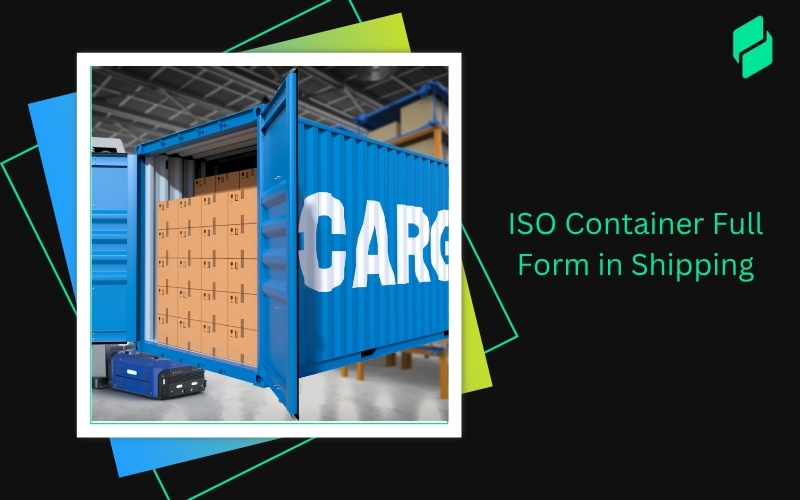Optimize your business: use unlimited savings with Pazago fulfilled now!
Get Started ->Every international shipment must pass several checks before reaching its destination. One critical checkpoint is the ENS, short for Entry Summary Declaration.
You may have come across this term on freight invoices or during customs discussions and wondered, "What exactly is an ENS charge, and why am I paying for it?"
This blog will walk you through what an ENS charge covers, why it exists, who needs an ENS code, and how to register for one. We will also look at the key data points required for this process.
TL;DR
- ENS (Entry Summary Declaration) is a mandatory customs filing for shipments entering the EU, ensuring compliance with security and risk management protocols.
- The ENS charge covers the costs of preparing and submitting this filing, including administrative and platform fees, and is typically added to the shipping invoice.
- Filing Deadlines: ENS must be filed before goods arrive at the EU port, with specific deadlines based on transport mode (e.g., 24 hours for sea freight, 4 hours before arrival for air).
- Filing Responsibility: The carrier, freight forwarders, or customs brokers are typically responsible for submitting the ENS, and failure to comply can result in delays, fines, or shipment rejections.
What is an ENS Charge?
ENS in shipping stands for Entry Summary Declaration. It is a mandatory security filing required by customs authorities in certain regions, most notably the European Union (EU).
Through the implementation of EU Regulation 1875/2006, the European Union made it mandatory for all carriers to file an ENS declaration for cargo inbound into EU ports.
Shipping lines or freight forwarders must submit this declaration before goods enter the customs territory. The ENS filing provides critical information about the cargo, its origin, and its movement.
An ENS charge is the fee that shipping carriers or freight forwarders apply to cover the cost of preparing and submitting this declaration on behalf of the shipper. It ensures compliance with customs regulations and helps avoid potential fines, delays, or shipment holds.
Clarification for Indian Shipments
ENS charges and filing are specific to shipments entering the European Union (EU) and do not apply to shipments solely within or originating from India unless the goods are destined for the EU. For shipments that are only within India or not headed for the EU, different customs procedures and charges are applicable.
When your cargo is destined for a country that requires an ENS filing, the ENS charge is the cost you incur to have that documentation processed correctly and on time.
Example of an ENS Charge
Suppose you are exporting goods from India to Germany by sea. The container is scheduled to load at the Port of Mundra and arrive at the Port of Hamburg.
Before loading, your freight forwarder must file the Entry Summary Declaration (ENS) with German customs. For this service, the logistics provider adds an ENS charge to your shipping invoice.
ENS Charge: €25 to €50 (₹2,513- ₹5,027) per shipment, depending on the freight forwarder and the port of entry.
This charge typically covers:
- Filing of the ENS through the required EU customs system
- Use of the carrier’s security filing platform
- Administrative handling and processing of shipment data
Note: The ENS charge applies per shipment, not per container. The exact fee can vary based on the type of goods, number of amendments, and destination country.
Also Read: Guide to Various Types of Freight and Shipping Charges
Why is the ENS required?
The Entry Summary Declaration (ENS) in shipping is essential for customs security and risk management. Authorities require this filing for several key reasons:
- Advanced Cargo Screening: Customs officials utilize ENS data to screen shipments before they arrive at the destination port. This helps identify and mitigate potential threats, including illegal goods, contraband, and security risks.
- Supply Chain Transparency: The ENS provides detailed information about the cargo, shipper, consignee, route, and carrier. This enhances transparency in international trade, allowing authorities to track the movement of goods more effectively.
- Faster, More Efficient Customs Clearance: By receiving this information in advance, customs can process low-risk shipments quickly. This reduces bottlenecks at ports and helps compliant businesses move goods smoothly through the supply chain.
- Alignment with International Security Standards: The ENS supports compliance with global security initiatives such as the World Customs Organization SAFE Framework of Standards. This promotes consistency and cooperation across countries and regions.
- Facilitates Risk-Based Inspections: With early visibility of cargo data, customs can focus inspection resources on higher-risk shipments. This targeted approach reduces unnecessary checks on low-risk goods, saving time and resources for both customs and businesses.
Suggested Read: Understanding Shipping Costs from China to India
Who Needs an ENS Code?
If you are involved in international shipping to the European Union (EU), you need an ENS code. The ENS, or Entry Summary Declaration, is a mandatory requirement for anyone responsible for bringing goods into the EU’s customs territory.
This includes:
- Exporters and Freight Forwarders: If you are an exporter shipping goods by sea, air, rail, or road into the EU, you must ensure that an ENS filing is completed before the goods arrive at the first EU port of entry.
- Shipping Lines and Airlines: Carriers transporting the goods are legally responsible for submitting the ENS declaration to the customs office of the entry port.
- Customs Brokers and Logistics Providers: Many businesses hire brokers or freight forwarders to manage ENS filings on their behalf. These intermediaries must have a valid ENS code and a clear understanding of customs procedures.
- Importers: While the importer may not directly file the ENS, they should coordinate with the exporter, carrier, or customs agent to ensure compliance. Missing or late ENS filings can cause delays, penalties, or even rejection of the shipment.
In short, anyone involved in the transportation of goods into the EU, whether you are shipping, carrying, or facilitating the movement, needs to understand and comply with ENS requirements.
Pazago simplifies this process by offering tools that support customs compliance and real-time shipment visibility, helping businesses stay aligned with EU regulations without slowing down their operations.
You Might Also Like: Understanding Carriage Charges: Definitions, Types, and Examples
Which Data is Included in the ENS?
The ENS must provide complete and accurate shipment details. Here’s what is typically included in an ENS in shipping:
- Consignor and consignee details: Full name, address, and identification numbers of both the sender and the receiver.
- Carrier information: Name and identification of the carrier transporting the cargo.
- Goods description: A clear and accurate description of the goods, including HS codes.
- Packaging details: Number of packages, type of packaging used, and markings.
- Transport information: Mode of transport (sea, air, rail, road), transport document number (such as Bill of Lading or Airway Bill), and container numbers if applicable.
- Loading and discharge ports: Names and UN/LOCODEs of the port where goods are loaded and where they will be discharged.
- Voyage information: Estimated arrival times and details about the journey.
By providing this information in the ENS, shippers ensure compliance with customs regulations and avoid potential delays, fines, or shipment holds.
Also Read: Understanding the Difference Between Demurrage and Detention in Shipping
How to Register For an ENS Code?

Before your goods can enter European ports, you must file an Entry Summary Declaration (ENS). This requires an ENS code, which plays a key role in customs clearance and compliance with EU regulations. The registration process is straightforward, but attention to detail is critical to avoid delays or fines.
Here is how to register:
- Choose an Authorized Representative
If you are a non-EU trader, appoint an authorized representative such as a freight forwarder, customs agent, or logistics company to handle the ENS filing on your behalf. EU-based companies can manage this directly or through a partner.
- Obtain an EORI Number
An Economic Operators Registration and Identification (EORI) number is mandatory. This unique ID connects your business to EU customs systems. You can apply for an EORI number through your country’s customs portal.
- Prepare Accurate Shipping Information
Gather all required details:
- Consignor and consignee information
- Shipping route
- HS codes for the goods
- Container numbers
- Vessel and voyage details
- Estimated time of arrival
Incomplete or inaccurate information can result in the rejection of your declaration.
- Know the Filing Deadlines
Filing deadlines vary by mode of transport:
- Maritime (containerized): At least 24 hours before loading at the port of departure.
- Air freight: Shortly before takeoff.
- Rail and road freight: Before arrival at the EU border.
Late filings can lead to penalties or shipping delays.
- Submit the ENS Declaration
File the ENS through the national customs IT system of the EU country where your goods will first arrive. Your logistics partner can manage this electronically. Once accepted, the system will generate an ENS code.
- Understand Country-Specific Variations
ENS requirements apply across the EU, but individual member states may have slight differences in their filing procedures. Always verify the process with the customs authority of your destination country.
- Update for Any Changes
If any shipping details change after the declaration is filed, such as vessel schedule or cargo details, submit an amendment promptly. Failure to do so may result in non-compliance.
- Verify Customs Risk Assessment
Customs authorities will review your ENS and assess potential risks. Low-risk shipments clear faster. Maintaining a solid compliance record and working with reputable logistics partners helps improve your risk profile.
- Track and Manage Your ENS Code
Once issued, record your ENS code and share it with all involved parties, including the shipping line, port authorities, and customs brokers. Without this code, your shipment will not be cleared for entry.
Suggested Read: What Are The Differences Between FOB Shipping Point And FOB Destination?
When to File for an ENS?
You must file an Entry Summary Declaration (ENS) before goods enter the customs territory of the European Union (EU). The filing deadline depends on the mode of transport:
- Maritime (short sea shipping): At least 2 hours before arrival at the port.
- Maritime (deep-sea shipping): 24 hours before loading at the port of departure.
- Air transport: 4 hours before arrival or at the time of take-off for short-haul flights.
- Rail and inland waterways: 2 hours before arrival at the customs office of entry.
- Road transport: 1 hour before arrival at the customs office of entry.
Timely filing ensures that customs authorities can perform necessary security risk assessments and that your cargo moves smoothly through EU borders. Late or incorrect submissions may result in delays, penalties, or rejection of goods.
How Pazago Supports Businesses in International Shipping

An Entry Summary Declaration (ENS) is required for shipments entering the European Union (EU). It provides customs with advanced cargo details to assess risks. Filing the ENS involves administrative work, which leads to ENS charges.
Here’s how Pazago simplifies this process:
- Simplified Payments: Pazago streamlines payment for ENS filings by consolidating charges and offering secure, centralized payment options, helping businesses avoid delays caused by payment errors or missed deadlines.
- Clear Visibility: The platform offers transparency into overall shipping operations, enabling businesses to plan more effectively and avoid unexpected roadblocks.
- Centralized Documentation: Pazago stores all customs documents, including ENS declarations, in one place for easy access and tracking.
- Regulatory Compliance: Pazago stays updated on EU customs rules, helping businesses maintain compliance and avoid fines or shipment holds.
- Smooth Coordination: Pazago connects shippers, freight forwarders, and customs brokers to streamline ENS filing and ensure all stakeholders are aligned.
By managing ENS filing, charges, and compliance, Pazago helps businesses avoid delays and run smoother international shipping operations.
Conclusion
Managing shipping regulations, such as the Entry Summary Declaration (ENS), is crucial for ensuring smooth customs clearance and uninterrupted supply chains. When businesses handle these filings correctly, they avoid costly delays and strengthen their competitive edge in global markets.
As trade regulations evolve, companies are relying on technology to simplify compliance and streamline logistics. Tools like Pazago help by centralizing documentation, improving visibility, and automating key processes. This makes it easier to manage ENS filings and keep shipments moving.
Curious how Pazago can support your shipping operations? Book a demo with us today. We are here to help.
FAQs
1. What is ENS in shipping?
A. ENS (Entry Summary Declaration) is an electronic document required by EU customs for all goods entering the European Union (EU). It includes shipment details that help customs authorities assess safety and security risks before the cargo arrives.
2. Why do I need to file an ENS?
A. An ENS filing is mandatory for compliance with EU customs regulations. It enables risk assessment and protects EU borders. Failure to file may lead to shipment delays, fines, or refusal of entry.
3. Why is there an ENS charge on my invoice?
A. The ENS charge covers the cost of preparing and submitting the declaration to customs. It includes data collection, system access, administrative processing, and ensuring compliance with submission deadlines.
4. Who is responsible for submitting the ENS?
A. The carrier usually files the ENS, but freight forwarders or customs brokers may handle it on the shipper’s behalf. Responsibility often depends on Incoterms and shipping arrangements.
5. When must the ENS be submitted?
A. For sea freight, the ENS must be filed at least 24 hours before cargo loading at the port of departure. Deadlines vary for air, road, or rail shipments based on transit times and customs rules.


.png)


.png)





